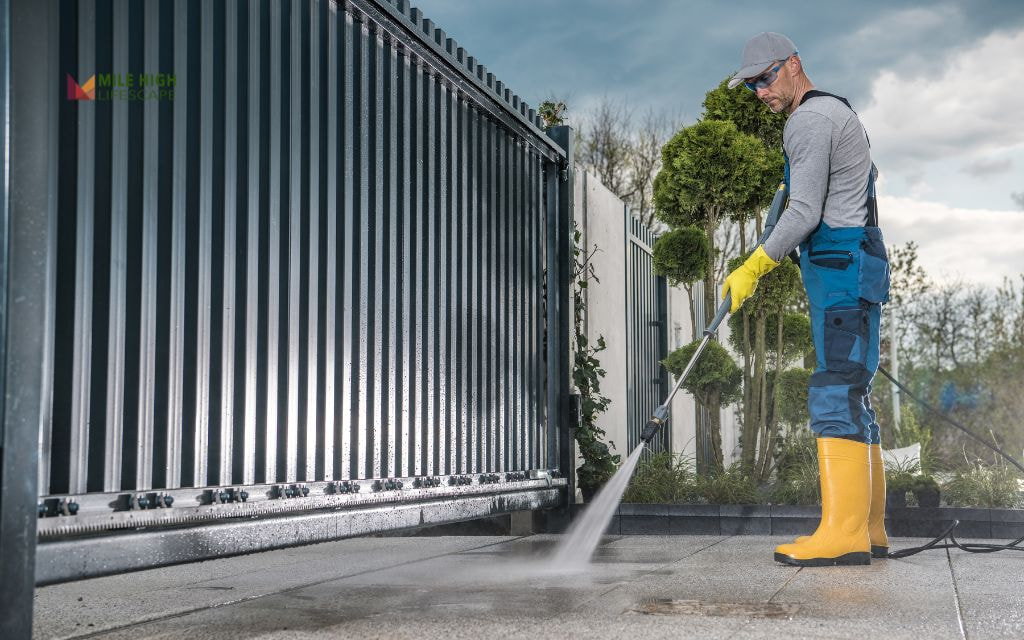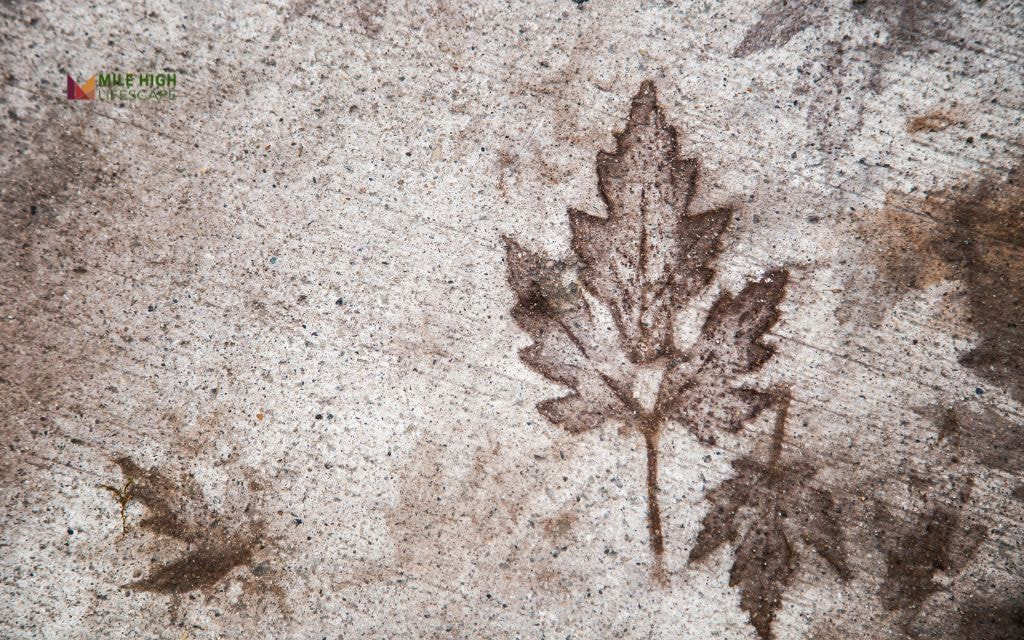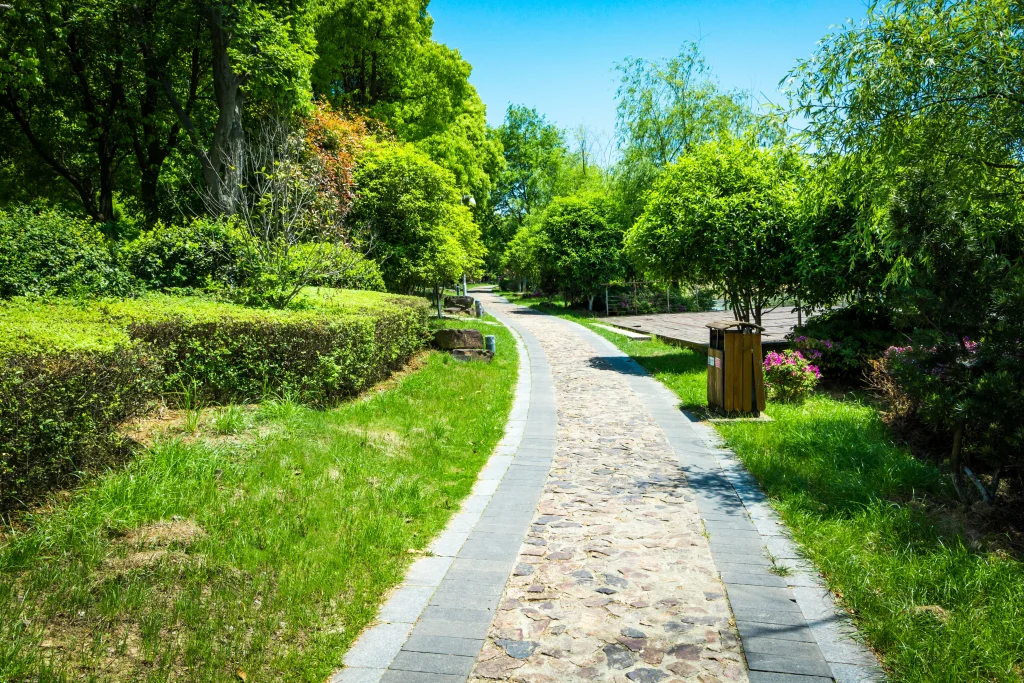When autumn leaves settle on your concrete surfaces and winter moisture sets in, those beautiful fall colors transform into unsightly brown stains that penetrate deep into your concrete.
To start the process of how to remove leaf stains from concrete, sweep away any loose debris from the surface. Then, prepare a mixture of water and dish soap or a bleach-based detergent, apply it to the stained concrete, and scrub vigorously using a stiff-bristle brush.
This guide gives you a clear, safe guide – specifically for Denver homes. You’ll learn how to remove leaf stains from concrete effectively, which products work best at our altitude, and how to prevent future damage through proper maintenance and sealing.
Key takeaway:
- Clean leaf stains within 24-48 hours before Denver’s UV and freeze-thaw cycles set them permanently.
- Use detergent for light stains, baking soda/vinegar for medium, and pressure washing for heavy stains.
- Never mix cleaning chemicals and always test hydrogen peroxide in hidden areas first.
- Sweep leaves immediately and seal concrete every 1-2 years to prevent future staining.
- Call professionals for deep-set stains or when DIY methods fail after multiple attempts.
How Do You Prepare Before Cleaning?
Risk Assessment: Light vs Stubborn Stains
Light stains appear as faint brown discoloration that recent leaf contact created. These respond well to basic cleaning methods.
Stubborn stains show deep brown or black marks that multiple seasons of leaf accumulation caused. These require aggressive treatment or professional intervention.
Safety Essentials
Wear protective gloves, eye protection, and dust masks when handling cleaning chemicals.
Never mix different cleaning chemicals together, especially bleach with vinegar or ammonia, as this creates toxic gases.
Denver’s dry air increases chemical vapor concentration, making respiratory protection crucial. Work in well-ventilated areas and keep pets and children away from cleaning zones.
Climate Considerations
Clean concrete when temperatures range between 50-75°F for optimal chemical effectiveness. Denver’s temperature fluctuations mean early morning or late afternoon provide ideal conditions.
Avoid cleaning during windy conditions that scatter debris and chemicals. Check weather forecasts to ensure 24-48 hours of dry conditions after cleaning.

Essential Tools and Materials
Cleaning Tools
- Stiff-bristle brush for scrubbing stained surfaces
- Garden hose with adjustable spray nozzle
- Pressure washer rated for 1,200+ PSI minimum
- Plastic scraper for removing surface debris without scratching
Basic Cleaning Solutions
- pH-neutral detergent for gentle stain removal
- Baking soda for creating alkaline cleaning paste
- White vinegar for natural organic matter breakdown
- 3% hydrogen peroxide for oxidizing organic stains
Advanced Cleaning Products
- Commercial concrete cleaner as backup for resistant stains
- Oxygen bleach for pressure washer application
- Simple Green Pro HD or Zep Commercial products for heavy-duty cleaning
Safety Equipment
- Protective gloves to prevent skin contact with chemicals
- Eye protection against chemical splashes
- Dust masks for respiratory protection in Denver’s dry air
Additional Supplies
- Plastic spray bottles for applying vinegar solutions
- Measuring cups for proper solution ratios
- Clean rags or towels for spot cleaning and drying
How to Remove Leaf Stains from Concrete?
For Light Stains
Wet the stained area thoroughly with your garden hose. Mix two tablespoons of pH-neutral detergent with one gallon of warm water.
Apply the solution generously over the stain and let it sit for 10 minutes. Scrub vigorously with your stiff-bristle brush using circular motions. Rinse thoroughly with clean water, ensuring no soap residue remains.
For Medium Stains
Baking Soda Paste: Combine three parts baking soda with one part water to create a thick paste. Spread evenly over the stain and let sit for 15-30 minutes. Scrub with your brush and rinse completely. This method neutralizes acidic stains effectively.
Vinegar Solution: Mix equal parts white vinegar and water in a spray bottle. Spray the stain generously and let sit for 10-15 minutes. Scrub thoroughly and rinse with clean water. Vinegar breaks down organic matter naturally.
Hydrogen Peroxide Treatment: Apply 3% hydrogen peroxide directly to the stain. Test a small, inconspicuous area first as hydrogen peroxide can permanently lighten or discolor some concrete surfaces. Let sit for 15 minutes, scrub, and rinse thoroughly. This method works particularly well on organic stains.
For Heavy and Dyed Stains
Use a pressure washer with 1,500-2,000 PSI and a 25-degree nozzle for concrete safety. Maintain 6-12 inches distance from the surface to prevent damage. Start with water alone, then add oxygen bleach or specialized concrete cleaner to the detergent tank.
Commercial Cleaners for Stubborn Cases
When DIY methods fail, commercial concrete cleaners offer stronger formulations. Choose products specifically designed for leaf stains and organic matter. Follow manufacturer instructions precisely, as Denver’s dry climate can concentrate chemical effects.
Always perform patch tests in hidden areas. Popular brands include Simple Green Pro HD and Zep Commercial products.

How Do You Troubleshoot Common Issues?
Learning how to remove leaf stains from concrete includes understanding common problems that arise during cleaning and their effective solutions.
| Problem | Cause | Solution |
| Stain Won’t Lift | Deep penetration or wrong method | Try pressure washer or hydrogen peroxide treatment |
| White Film After Drying | Soap or chemical residue | Rinse again with clean water or diluted vinegar wash |
| Surface Discoloration | Chemical too harsh or over-exposure | Buff surface and neutralize with baking soda solution |
| Uneven Results | Inconsistent pressure or scrubbing | Repeat process lightly over entire area |
| Returning Stains | Sub-surface penetration | Deep clean and seal concrete after drying |
What Tips Can Help You Clean More Effectively?
- Use warm water: Warm water activates cleaning compounds more effectively than cold water. The heat helps break down organic matter and improves chemical penetration into concrete pores.
- Allow proper soaking time: Let cleaning solutions sit for 15-30 minutes before scrubbing. This extended contact time allows chemicals to penetrate deeper into concrete and break down stubborn stains at the molecular level.
- Apply Circular Scrubbing Technique: Scrub in circular motions rather than straight lines to increase contact surface area with stains. This technique provides more thorough coverage and prevents streaking patterns on the concrete surface.
- Work in Manageable Sections: Divide large areas into smaller sections to prevent cleaning solutions from drying before rinsing.
- Implement Double Rinse Method: Rinse twice for optimal results – first to remove loosened grime and stains, second to eliminate any chemical residue that could attract future dirt. Thorough rinsing prevents white film formation and extends cleaning effectiveness.
- Allow Natural Drying Process: Let surfaces dry naturally without forced air or heat. Denver’s low humidity speeds natural drying while preserving concrete integrity and preventing thermal shock that could damage the surface.
- Avoid Immediate Traffic: Keep foot traffic off treated surfaces for 24 hours to prevent recontamination and allow complete drying. This waiting period ensures maximum cleaning effectiveness and prevents new stains from forming on the clean surface.
How Can You Prevent Future Leaf Stains?
Sealing Benefits
Concrete sealing creates a stain-resistant barrier that prevents leaf tannins from penetrating surface pores. Choose acrylic epoxy sealers designed for Denver’s climate extremes. These products resist UV damage and freeze-thaw cycles that plague our region.
Optimal Sealing Timing
Apply sealers after deep cleaning in late spring or early summer when temperatures remain consistently above 50°F for 48 hours. Denver’s intense UV requires resealing every 1-2 years to maintain protection. Fall application provides winter protection but requires precise timing before temperature drops.
Maintenance Strategies
Sweep leaves immediately after they fall, especially during Denver’s sudden autumn storms. Hose down concrete surfaces weekly during leaf season to prevent stain development. Remove snow and ice promptly in winter, as freeze-thaw cycles drive stains deeper into concrete.
Install proper drainage around concrete surfaces to prevent water pooling that accelerates stain formation. Trim overhanging branches to reduce leaf accumulation and improve air circulation around concrete areas.

Conclusion
How to remove leaf stains from concrete requires systematic preparation, appropriate methods for stain severity, and consistent maintenance. Start with assessment and safety preparation, apply the cleaning method that matches your stain intensity, and finish with proper sealing for long-term protection.
Understanding this technique effectively helps protect your investment and maintains your property’s appearance year-round. Act before winter sets in to prevent stains from becoming permanent fixtures on your concrete surfaces.
For nearly two decades, Mile High Lifescape has been proudly serving the Denver Metro area as the go-to landscape company. With a reputation for excellence, we offer a comprehensive range of friendly and professional landscaping and lawn care services, also yard cleanup service.
Give us a call at (303) 877-9091 and get your free estimate today!
Frequently Asked Questions (FAQs)
What takes leaf stains off concrete?
Dish soap and water handle light stains, while baking soda paste, vinegar solutions, or hydrogen peroxide remove medium stains. Heavy stains require pressure washing with commercial concrete cleaners.
Is it possible to remove stains from concrete?
Yes, most leaf stains can be removed with proper methods and persistence. Fresh stains respond to basic cleaning, while old stains may require multiple treatments or professional intervention.
Will mineral spirits remove stains from concrete?
Mineral spirits work on oil-based stains but prove less effective on organic leaf stains. Use vinegar or hydrogen peroxide for better results on tannin-based discoloration.
Will snow melt chemicals damage concrete?
Salt-based deicers can damage concrete through freeze-thaw expansion. Use calcium magnesium acetate products designed for concrete safety, and rinse surfaces when temperatures allow.
How long after cleaning can I seal?
Wait 24-48 hours after cleaning before applying sealer. Concrete must be completely dry for proper sealer adhesion and effectiveness.
Can I clean when it’s below freezing?
Avoid cleaning below 32°F as water freezes in concrete pores, potentially causing cracking. Wait for temperatures above 50°F for 24-48 hours before and after cleaning.
